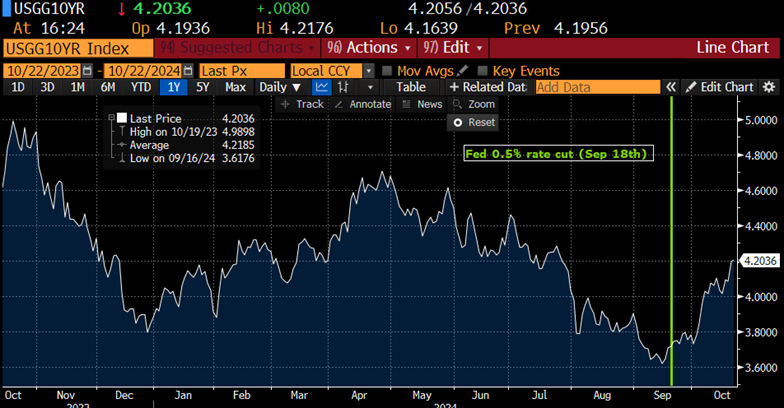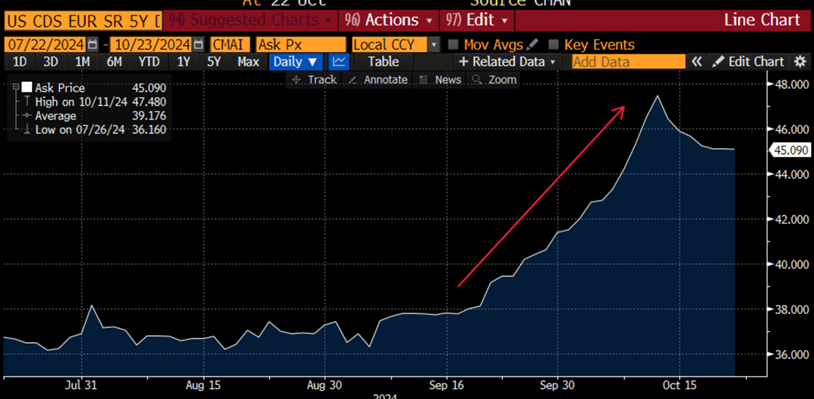
The Fed’s Narrative: Market Confusion and USD Volatility
15 October 2024
Mitigating Market Risk in Private Equity Acquisitions Through Deal Contingent Hedges
24 October 2024INSIGHTS • 23 OCTOBER 2024
The Short Story of the Long End (of Yield Curve)

Kambiz Kazemi, Chief Investment Officer
“It’s the type of thing that should keep people awake at night” – Janet Yellen, on the 75% Debt to GDP ratio and $20 trillion of public debt.
November 2017.
Seven years later, one wonders how the Secretary of Treasury manages to get any sleep at all with Debt to GDP ratio standing at 123% and public debt swollen to $35.5 trillion, as per the statement published on October 18th, 2024.
These developments in US debt might be no stranger to what we have been witnessing in the bond markets. It is quite something that despite the Fed’s 0.50% cut in September, 10-year Treasury rates surged by nearly 0.60% within a month, reaching 4.20%!
Chart 1: 10 Year treasury rates

Source: Bloomberg
Historically, lower overnight rates and expectations, or the actual start, of the cutting cycle have typically been accompanied by a drop in rates across the yield curve.
Yet, despite an important initial rate cut and continued expectations for further easing – albeit less acute – into the end of 2025, long-term interest rates have risen over the last month.
What could be behind this rise of the long end of the yield curve? Is it a signal for what might be coming, or is it a symptom of existing forces? Let’s explore some potential explanations.
1. Slower and lesser (rate cuts)
Recent economic data, particularly the robust September unemployment figures, have generally been healthy and surprised the markets to the upside. The risk of a recession has all but evaporated, and a soft landing now seems to be the likely worst case scenario for analysts and pundits.
As a result, the market has adjusted its path of rate cuts. While rate cuts are still expected to continue through the end of 2025, the projected terminal rate has been roved up to 4.10% from 3.5% a month ago.
As such, part of the adjustment in long term rate expectations can undoubtedly be explained with this correction in short term rates.
2. Debt and fiscal uncertainty
The recent joint statement by the US Treasury and the Office of Management and Budget (OMB) highlighted the continued trend of higher debt and deteriorating fiscal health. With the debt to GDP ratio surpassing 120%, reaching record levels not seen since post World War II, concerns are mounting.
While the US government’s balance sheet and ability to service its debt has historically been unquestioned, the lack of clear commitment from politicians or either possible incoming administration to tackle the issue at its core seems to be starting to instill the seeds of doubt.
Fiscal austerity is a word markets have not heard in a long time, and both candidates’ proposed policies appear to be driving further deficits, potentially exacerbating the national debt.
Under such conditions, compounded by a higher cost of servicing the debt due to higher interest rates, it is unsurprising that bond bears and vigilantes are coming out of hiding.
A closer look at the 5-year Credit Default Swaps for US Treasuries – which measures the cost of insuring against a default of US Treasuries – confirms our hunch, having risen by 25% to 0.46% in the last month and half. This means it costs 0.46$ per year to insure against a default of US Government on $100 of its debt, up from 0.35$ in early September.
While this figure remains low and is far from prohibitive, it is significantly above the 0.18$ average from 2014 to 2022.
Chart 2: 5-Year Credit Default Swap (CDS) for US Treasuries

Source: Bloomberg
At this juncture, we highly recommend closely monitoring the evolution of the long end of the curve. For those with floating rate exposure, a thorough analysis of their portfolios and a consideration of hedging and/or restructuring strategies may be prudent.
It’s also essential to remember that 30% of outstanding US Treasury bonds are held by foreign investors who have been marginal buyers since the Fed bond buying programs have subsided. While not an immediate concern, if their fate or interest in US debt is shaken, the risk of increasing long-term could be much higher.
Be the first to know
Subscribe to our newsletter to receive exclusive Validus Insights and industry updates.


